#and these refs are usually my time to practice anatomy
Explore tagged Tumblr posts
Text




New girl alert!!! New PC for a new campaign!
(Pose references from @adorkastock)
Lineart and full res found over here!
#my art#winter zinsbog#dnd#dnd oc#dnd 5e#i love using adorkastocks references when im still nailing down character design#and these refs are usually my time to practice anatomy
35 notes
·
View notes
Text





[*inhale*] GUESS WHAT??? IT APPEARS THAT I HAVE FORGOTTEN HOW TO DRAW THE SIMPLEST OF SEMI-SIDE PROFILES FOR MY CHARACTERS!!!!! CURRENTLY, I CANT DRAW SHIT!! I think this may be art block. WELL WHATEVER IT IS, WHAT THE ACTUAL HELL, THE AUDACITY THAT MY ARTING SKILL HAS RIGHT NOW IS ABSOLUTELY ATROCIOUS!!!!! HOW DARE IT!!! ! IT S. AN EXTREMELY EASY GODDAMN SEMI-SIDE PRFOILE OH MY GOD A I AM GOING TO FUKING BIRD SCREECH IN RAGE
Normally I am able to 3D everything. All of their facial structure. All the anatomy when I draw them semi-realistically. Without references a lot of the time. (Unless I wish to specifically get into the muscular structure because that’s more difficult to memorise) BUT NOW……? HAHAH MY BRAIN JUST SAID, NUH UH!!! NO VAS A DIBUJAR UNA MIERDA PARA LOS PRÓXIMOS 1P2303334 MESES, QUE TE JODES!!!
worst thing is that I have AN UNBELIEVABLE AMOUNT OF IDEAS THAT I NEED TO PRINT FROM MY MIND ONTO THE PHYSICAL WORLD BUT I CAN’T NOW
Oh my… sorry about that long rant, I got a bit carried away…
Anyways, take some anatomy studies of feline faces for now as I try to COMPLETELY ANNIHILATE this bothersome artblock.
#Hmm one thing i have noted though is that usually when such annoying artblock happens to me it usually means level up time for my art skills#art#cat#bazookaboi’s art stuff#Bazookaboi’s shitpost stuff#anatomy practice#I took the refs from Pinterest so uh… I don’t know who to credit o-o#feline#anatomy study#sketch#don’t know how to tag this
49 notes
·
View notes
Note
SHAKES YOU how do you draw taurs. i need help i genuinley cant wrap my head around the anatomy of it. optionally i need help with fat taurs but any kind of taur is okay
Ooh, I love these sorta questions!!!
So there are two main things folks usually struggle with when it comes to drawing taurs as a whole. 1, they struggle with quadrupedal anatomy and 2. connecting the humanoid upper body to the quadrupedal lower body. Obviously there's no shame in either of these things, drawing four legged animals, especially if you're more used to the anatomical structure of something more humanoid is quite tough! And finding the sweet spot where humanoid and quadruped meet to make a taur is a bit of a struggle for folks who're still figuring it out.
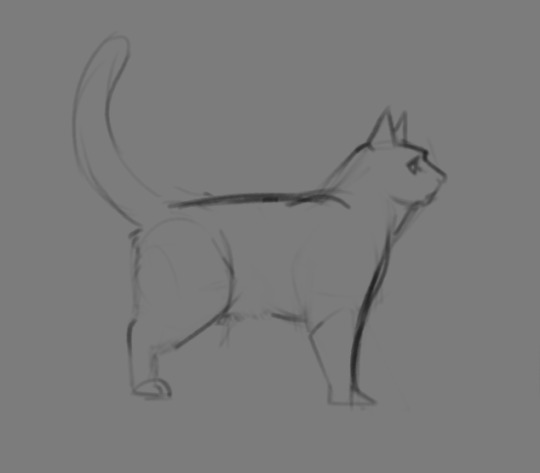
So! The first thing you wanna do really is just familiarize yourself with quadrupedal anatomy. Look at the skeleton of the creature you're trying to taur and see how things like their limbs bend differently or how they're just differently naturally posed as compared to someone who walks upright.
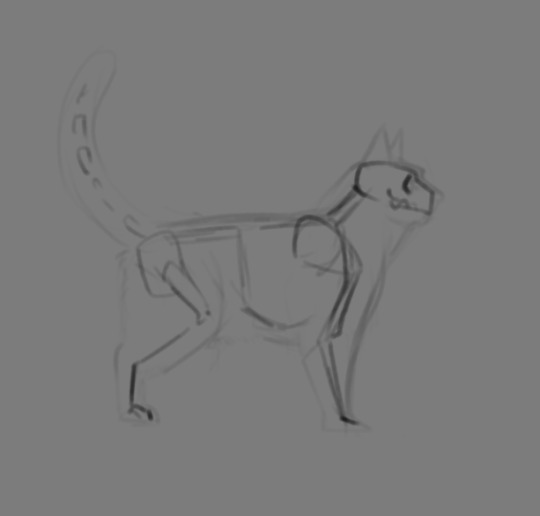
This is a very simplified skeleton of a cat, but you can pretty immediately see how differently everything bends. And I'm not saying it's something you have to perfectly master to know how to draw a taur (especially when you get to drawing fat taurs), but i highly recommend becoming familiar with how a quadrupedal body is structured, the silhouette of most animals is quite misleading! And absolutely use reference!
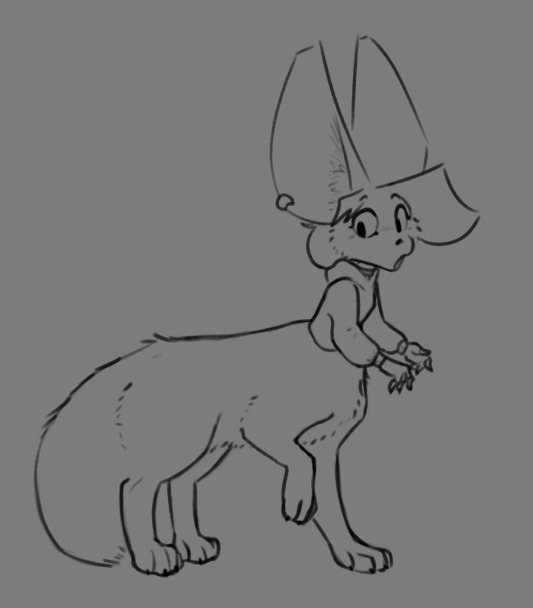
Heck, our first go at drawing taur Riley was super heavily referenced (I'll even share the ref image if anyone is interested!), and this still came out real jank. Practice makes perfect!
As for connecting the upper body to the lower body, this is a little more subjective and up to you, but I'll lay out some general guidelines.
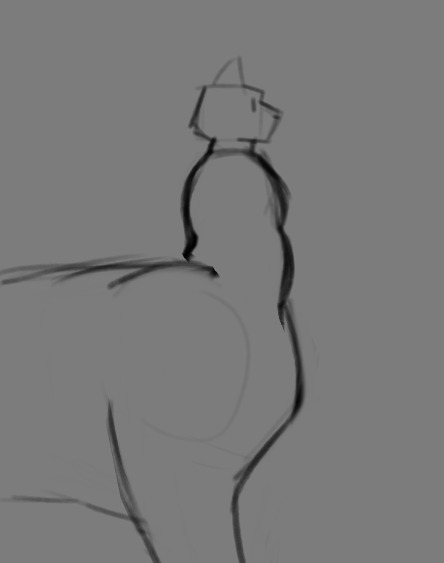
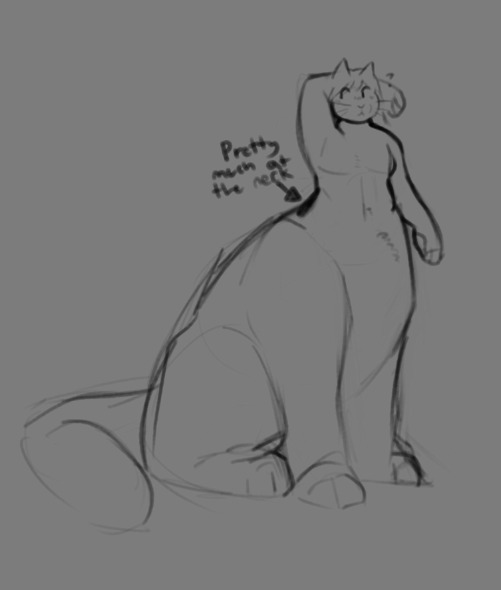
Generally speaking, you wanna put the humanoid torso where the base of the neck is, the front of the torso kinda merging with the rest of the taur body just after the tummy, basically just before the crotch starts.

As for the back, you're gonna want to shoot for just shy of where the butt starts, waist having curved back outwards. It gets a little awkward if you go higher or lower than that. And obviously, you wanna make sure the torso is firmly planted in the center of where the neck should be, ehehe.
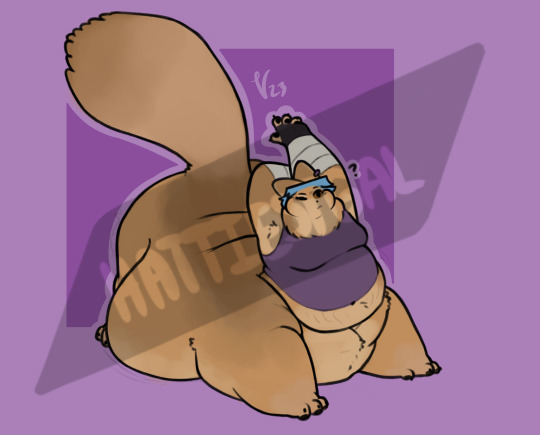
That's pretty much the basics though! As always, i recommend looking at how your favorite taur artists draw the creatures and studying off of that! Familiarize yourself with quadrupedal anatomy, and use reference!! You will absolutely get it down with time. I will absolutely cover fat taurs if there's interest in it, and ofc, lemme know if there's anything I missed or need to go over! I hope this helps!
#hat answers#my art#my ocs#Riley Foxglove#design talk#tutorials#taurposting#i imagine this one'll find a much more niche audience but i really do hope its helpful!#these are the two things that definitely gave me grief when i was first figuring out how to Taur#but im sure theres plenty more i missed!#never be afraid to ask about stuff!!!!!!
203 notes
·
View notes
Note
I'm a pretty young artist and I'm not sure what I need to start off with.
Anatomy or color?
tl;dr there's no correct answer for this.
but you can start off by asking yourself what do i want to draw? what do i want to draw right now? depending on your subject, what style you want to learn/do (painted, linework) then that can determine how you think while you draw.
however, you won't and never will learn one thing into completion and then move onto the next, its a continuous process of learning and relearning.
you can learn either anatomy or color one at a time, or dedicate time split for both. imo, you learn both best together. either way, you learn both continuously for the entire time that you will ever engage with drawing. there's always a lot to learn.
i feel like a lot of beginner artists get wrapped up on thinking that one should be prioritized over the other, so my answer to this question is long:
the usual route people go to for this question is to focus on fundamental studies. in the few semesters of fundamental courses i had, our structure was this:
learn solid forms, shape, lights, grayscale values, perspective AND gesture/figures
continue building on gesture/figures AND start learning color(traditional painting)
continue with gesture/figure + start learning anatomy AND continue learning color (digital painting)
we start off with many other basic building blocks first before getting to anatomy/color, but those basic blocks are essential to building up how you think when practicing both. but where do you put this in practice while drawing for fun? this is time dedicated for studying fundamentals, after all. schooling helps, but a majority of us start out as self taught, especially since there's a multitude of free learning resources online.
if your preference of learning is to do things one step at a time, then maybe dedicating your time to fundamentals is the way to go. there's lots of educational resources out there to help build these fundamentals. at the top of my head, here's a few resources for anatomy: proko, sinix design, glenn vilppu (great for gestures). if there's anything to take away from this regarding anatomy, its to practice perspective, form, gesture, and figure first and foremost. anatomy dives deeply into more complex forms. start simple before you get overwhelmed.
unfortunately, i dont have many resources to give you in terms of learning fundamentals for color. i primarily learned off of experimenting and studying off of other artworks. i've already covered a lot on my thought process behind how i think when painting, so that post might be insightful the moment you get more into using color.
now, im gonna assume that you haven't had formal schooling in art (either not yet, or won't), but you spend your time drawing for fun. and now you want to dedicate a bit more time and practice into anatomy/color. i started off self taught, so i can relate.
earlier, i mentioned this question:
where do you put [fundamentals] in practice while drawing for fun?
when looking at your question again, i think of this: do i want to practice fundamentals as i draw for fun?
there's definitely a difference and spectrum between "going balls to the wall crazy and drawing for fun" and "using my drawing time for studies/practicing fundamentals."
if your answer is yes to that question above, then you're on the right track for seeing how this works in practice the moment you participate in both "drawing for fun" and "practicing fundamentals" for self practice.
in any drawing i do, i want my subjects to be posed as [xyz], but i also want the final illustration to look like [xyz] for color.
i gather references for both posing and color, and while drawing i look to study both at the same time. with posing, im looking at refs to study anatomy as i draw. sometimes i may only use one ref photo, or multiple, but either way im checking for various information like what are the proportions, how might the skin fold, what areas of body have soft/hard edges, what might these limbs look like when foreshortened, etc. with color refs i study them to analyze how another piece of artwork is doing something that i'd like to achieve in my own art. this goes back to things i've mentioned here.
in short, the time drawing for fun is also a time to put fundamental practice in place that helps build your skills as an artist. either way, my advice is to learn as you go and have try to have fun while you practice.
in the end, this is my perspective when i look at this question. others may disagree and have a different opinion, but at the end of the day, everyone has a different process on how they practice and grow as an artist.
this was lengthy, but this is an extremely broad question that goes beyond choosing one or the other, and there's reasons why that is. i hope i explained this well enough and that it answered your question in some way!
51 notes
·
View notes
Note
I've admired your work for a long time and personally love your art style, it looks so top-tier and professional! I'm trying to get back into drawing, do you have any tips on how to develop art skills? Maybe your journey as an artist?
My journey has been going since I was a little kid. I've always drawn, so a lot of it is self-taught stuff building up on itself. However, I think these things can really help speed up understanding art as a process: 1. Use references, please god. I did not use refs for a majority of my life as a self-taught artist and though I got there in the end, references saves a world of headache in both anatomy placement and just posing. You don't have to draw 3/4 standing poses for all your practice/sketching!
Gesture drawing is a rly nice way of also getting faster while learning to dissect a reference quickly. You understand what makes the pose readable in a few strokes, vs trying to nail down every muscle and bone placement. They're good to warm up to (which you should always warm up, be nice to your poor hands.) 2. Don't just admire, learn. When you see someone's art you like, take the time to think about why you like it. Why is it affective, what parts of it are clicking with you? If it's sketches and comics of someone's ocs or fanart, why is it resonating outside of being about a special interest you have? What about the ART is doing something? If it's a finished illustration or painting, there's usually choices the artist is making to get ideas or moods across. Being able to dissect and pay attention to art that we admire and like builds skills in doing it to our own. When we're unhappy with something, we can critically ask ourselves why instead of just saying it's bad. Just saying something is 'bad' or 'good' is ineffective in learning anything.
3. Be optimistic in learning! It's perfectly fine to enjoy drawing just as is, and not to constantly analyze what you and others make- but being open to studying, critique, and learning new and old concepts makes us better artists. Being receptive to knowledge is a good thing, always! So try, when studying, to enjoy the process of making the art and learning about art as much as the final product. If you hate making the thing, or just find it as a means to an end, you're gonna burn out quickly. Fall in love with the act of making something. Because it's a labor of love! Fall in love with learning about it, discovering new ways to do it, and so on because you can enjoy it more.
25 notes
·
View notes
Note
Hiiii
First of all I want to say that I love your art and I really admire it. It has kind of make me want to go back to drawing again. I used to draw a lot a few years ago but I stopped because I became unhappy with my progress. Now I want to go back to making art but I'm insecure about it because I'm worried I'm too old to start again (I'm 19) and whether I'm capable of relearning it properly. Do you have any tips about where to begin to learn art basics (specifically anatomy)? I would appreciate any advice.
Hello!!! Firstly thank you so much for the compliments, it really does mean so much <333
I'm nineteen, too! Of course you can start art again. I've taken a lot of breaks in between my own art, too, and it's only very recently that I started enjoying making art again (after .... like.... a year or two. lord) so I really do understand how you feel. But we're nineteen years young, and have so much time ahead of us to get back on our feet.
In my experience, improving comes quickest when you focus on one very specific skill at a time—and I mean SPECIFIC. Practicing gestures with torsos only, the muscles of the upper arm, skeleton heads in different angles. I've been studying arm anatomy (and only arm anatomy) recently, and I'm already miles ahead of how I used to draw arms in the past.
If you want a specific step by step on how I personally draw anatomy, I don't mind sharing a quick tutorial! But for general advice—form follows gesture, and gesture follows movement. The biggest mistake someone can make while drawing a body is focusing on the accuracy of the muscles/bones before getting the flow of the gesture down.
Even if the anatomy looks a bit wonky with the gesture, it's important that you capture the movement of the pose first, and then build muscle on top of that. Proko on Youtube has a very good quick drawing series on this, and explains it way better than I do, but that's the gist of it.
Also, PLEASE always use references! I know that hearing that gets old, but it's really important. If you'd like, I can make a quick tutorial on how to use references properly, too. Reference everything—pose, lighting, even art style if you're looking to switch things up (i have about 10 different tabs open on my computer with different artists I admire so I can reference their art religiously).
Speaking of referencing art styles, it's important to gather a bunch of artists you like in terms of style, and not just one. The trick is to separate them by skill—"this artist is for lining refs", "this artist is for anatomy refs", "this artist is for face refs", etc, etc.
And to jump off of That: I find that with anatomy, looking at other peoples' anatomy studies on pinterest is also very helpful. Obviously you should be referencing from real life too, but with art, it can be difficult to pin down what to put on the page and what to leave to the imagination. You wouldn't want to actually draw every single muscle in the arm individually, right? So I go and look at other artists' anatomy studies to see what they keep and what they don't keep.
(usually i find them on pinterest, and they look smth like this. the color coded ones especially help me.)
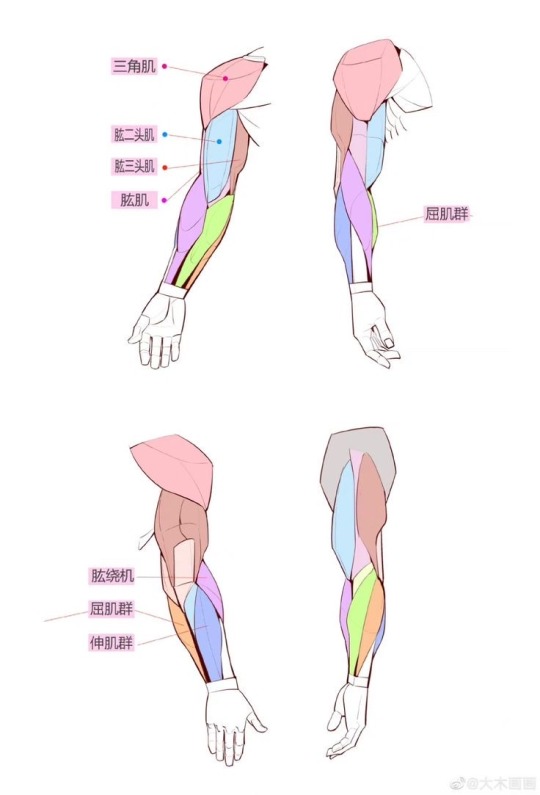
I'd recommend learning gesture and anatomy first, then building off of that to learn how to draw faces, then lining/coloring, just so that you have a solid base to work off on when it is finally time to color. (also because coloring/lighting requires a fair bit of how body anatomy works as well!!)
But yes, that's all the advice I can give from laying in my bed. I hope it helped somewhat, and if you'd like tips on how to do something more specific, I'm always willing to draw it out or go more in depth ^^ Best of luck on your art journey!
105 notes
·
View notes
Note
Can I ask where you get references and inspiration for your nsfw poses? Your art is literally so gorgeous it's motivating me to draw it too. <3
aaahhh tysm 😭💗💗 hate to break it to you but i rarely ever use refs!! only when i can’t figure smth out for the life of me or when i’m doing studies!! i don’t like using refs for regular art bc i always make it look stiff when i use them 😭 so i usually just construct my poses using simple shapes for the main body parts and landmarks (like collarbones, joints, hipbones, the lowest rib etcetc) while keeping in mind the perspective and how muscles behave depending on the direction of movement!! i studied bridgman and lauricella a lot and i’ve done tons of studies, loomis did constructive anatomy too but i don’t like loomis 😭 i prefer bridgman bc i like the shapes and the way he shows the twists and bends of the body!! ive learned a lot from sinix and moderndayjames on youtube too, they have really good anatomy tutorials!! other than that it’s just tons of practice and analysis, im ngl it took years to get where i am now but it was 100% worth it i hate wasting time searching for refs and it’s so hard to find exactly what you’re looking for too 😭 so i’m very happy that i can construct poses without them like 99% of the time!! i could do like a study stream sometime if anyone’s interested in seeing my process!!
18 notes
·
View notes
Note
So I came from your insta and saw that you improved quite a lot over two years. I’m in an art rut right now and was wondering your tactics for learning to draw different positions and poses? And fabric? I’m just curious since you don’t have speed draws on YT.
oh thank you!
in the past two years, i think what's helped me improve the most is learning the balance of keeping consistency without taking myself too seriously. i find that when i'm in a rut or i feel like i've stagnated, it's bc i'm too in my head and i'm forgetting to have fun. bc yes, technical skill is good to acquire, but creativity is, in my opinion, more important of a priority because that's where the art comes from. the technical skill is just the tool to help the art get made, so hone it, but don't treat it like it's everything. it's no good being able to draw a bunch of cool stuff if you don't have the spoons to draw any of it or if you're so burned out, you can't even come up with ideas.
on the more technical side though, for me, study and practice time are when i focus on repetition so i can build muscle memory. if i'm studying from references (and not feeling lazy lol) i'll draw each ref at least 2 or 3 times to get those reps in, drawing fast and sketchy, just doing as many as i can. this really helps with things you'll draw over and over again like clothing folds. my hand will start to just have a better intuitive sense for the shapes instead of agonizing over each one cuz i've drawn it enough times. when i'm sketching, it helps me to fall back on that muscle memory so i can put more focus to other aspects of whatever it is i'm drawing.
it's about finding a balance really.. if i study too much, i never actually implement the things i learn but if i study too little, then my work stagnates and all looks the same. finding that balance for yourself will go alone way! when i'm in an art block, what i need just really goes back to remembering to enjoy the process and finding that spark again. if i'm not enjoying my art, then i gotta switch something up.
here are some other things i like to do for practice:
redraw screenshots/stills from my fav shows or manga (good way to study poses, anatomy, and scene composition w/o it feeling too serious.)
or pick a show/movie/comic and choose a character i like. draw them 3-5 times, copying the art style to a T then draw them again in my own style to see what elements i wanna take away from it. (again, a good way to study without Studying. i end up leaving the experience with new staples for my art style)
find fashion photo references and draw my ocs in the outfits.
switch up what i'm drawing with. like if i'm mostly draw in pencil, switch to only pen. if i'm doing digital, i put my go-to brushes in a new folder, don't touch them, then sketch with a brush i never reach for. just change one little thing and see how it affects the process. usually i discover something new.
i wrote a list of things i like to draw on the front page of my sketchbook (just stream of consciousness, wrote down like 100 things i like to draw. ex: oranges, apples, snails, leaves.) and when i don't know what to draw, i close my eyes and point to something then draw whatever i comes up.
hope this helps!!
8 notes
·
View notes
Note
mwah your art is good and nice :>
can I ask for some advice? no worries if u don't want to answer.
do you have any tips on how exactly to practice art? everytime I ask for art advice everyone always says "practice" but idk what to practice first! do you have any strategies for learning how to draw something? do you do excercises? and if so how do they work?and are there any beginner mistakes I should look out for and change specifically?
thank you so much!! have a wonderful week :>
thank you so much! im ok w answering! i dont want to speak as if i am an expert on how to draw things in general as i am learning as well and definitely am not completely learned, so i might not be the best person to ask since im not very professional w my art as I do it as a hobby (and I can only speak on mostly digital cartoon matters) but i reallly hope to try and help u out even a lil ! im really happy that you’re eager to draw :] I wish you so much luck muwah muwah
i also hated when ppl told me “just practice” and i dont wanna inflict tht on u EITHER LOL but also thats just what i ended up doing for awhile but i tried to find some things to help ^_^
tips for practice: My number one rule is that practices should be challenging but still fun, I know it can get frustrating trying to redraw a pose over and over trying to get it perfect. And over time it rlly is all about muscle memory, the longer you draw the more your eyes will pick out specific shapes in everyday life and convert them into its own vision of them! or at least its good to look at life that way, try to pin point key shapes and stress less on details in practices. after you look at key points, THEN you can go over what you have and draw in and over it to make it more “complete.” To stop practices from getting too stressful I recommend starting out drawing what you want a little more simple looking than ur desired finished product. This helps eliminate the pressure of everything not looking “perfect” and keeps your art more loose and fun. Doing this a few times is gonna get ur brain to recognize patterns in art and how things look/flow in anatomy and such. dont get stuck in ur own head abt perfecting everything to the point you either 1) give up bc ur not at a level capable of it being 100% “perfect” or 2) focus so much on making it perfect that you end up saying the work looks “wonky” or stale in dynamics, So while I do think studies help, don’t get too lost in them. I always practice with media I enjoy too, whether it’s characters or fashion I enjoy.
Strategies learning to draw something: people get mad abt this one but I think tracing reference photos is great. its been awhile but When I tried learning to draw hands better at first I would trace them then put the traced image to the side of the canvas, then try and replicate what my mind saw as its most important angles and aspects. Same for clothing folds/hair/etc! I think it’s maybe not the best idea to trace the ref and use the tracings as is, because you learn more from tracing it then trying to replicate and simplify what u learned into the style you’re working in. Find what shapes you like from them and don’t over detail it. you may have to go by eye and think “what parts of this ref photo should i simplify to fit my style” and for me, its usually adjusting the length of the torso and then the limbs by associations. i dont recommend feeling like u need a reference for every art you make though, its ok to let ur own head try out its own sometimes too while trying to learn this, see if it remembers any call bad from the past referenced sketches! over time ull remember where everything goes more, these days i rarely kick myself to use refs but im sure they still would help to use, but figure drawing simple blobby figure in a bunch of random poses was a big thing i used to do as well to get better at full body art + overall dynamics (still does this). also paying attention to silhouettes is great
Exercises and how they work: I WANNA HELP U SO BAD BUT to be honest, all the works on my blog ARE exercises! i rarely actually do finished pieces, if u scroll thru my posts ull notice most r sketches. i usually just fill up a page and call it “warm ups” then i get attached to some of them, take a few, and just line them up pleasingly on a smaller page, then color them in (or sometimes fix the lines to be more clean too). im not rlly a person who “exercises” to practice, it more so happens from just me drawing a lot for fun as a hobby! but i really should. i will tell u this has humbled me a lil i need to start practicing too 😭 LOL but a good exercise is to look at what ur inspirations do, and study it. Make a collage and write out what you like most abt their styles/what u want to gain from them. For ref Here’s a page I did awhile ago when someone asked me abt my insps:
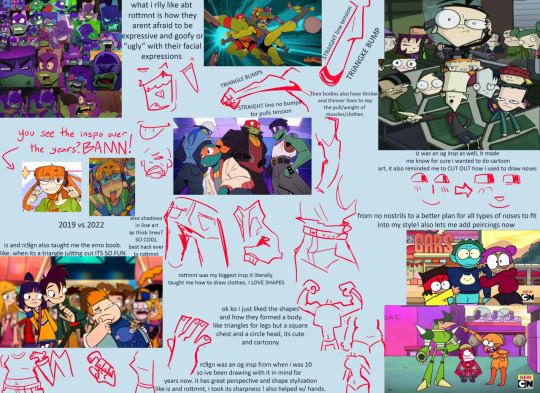
i also look at fashion magazines and as well as anime figures and take insps from that sometimes with learning cool poses and compositions to convert into my own things
Beginner mistakes to look out for: its hard for me to pin point “mistakes” beginners make, as sometimes we cant avoid all of them or even notice them, progress comes from growing out of old ways. some mistakes are even the foundation of ur future amazing cool style! but i think some things to look out for could be these, from my own old art experiences
Hands were the first thing I learned bc i liked drawing them. I don’t know if that is the best way to go but I think it is smart to practice sooner than later, here is a lil guide thingggyyy wingyyy from awhle ago
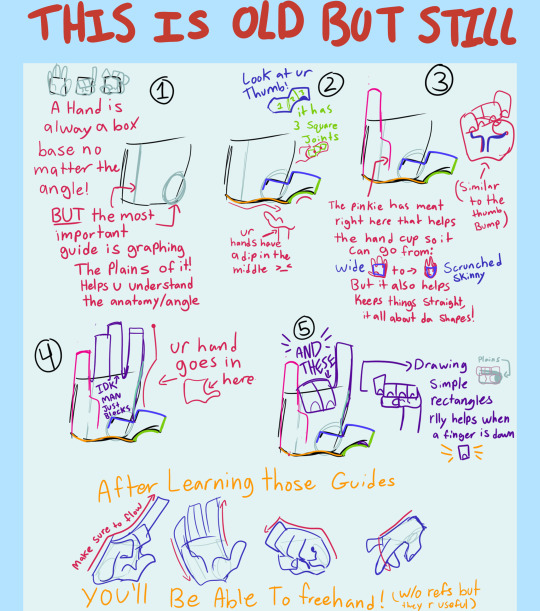
i see beginners shy away from drawing signs of age in people, sometimes adding too much detail on an older person in cartoon art makes it look weird, so i try and hit the key markings on ppls faces of age.
Too thin of lines. sometimes its a stylistic choice to use thin lineart, and it can look amazing ! but sometimes it can flatten an image if ur not familiar with its flow. im not saying use thick line art, but more so to keep in mind the weight of ur strokes, adding depth with a thick thin combo of line art can do SO much for the simplest of pieces. heres a visual from a while back when i talked abt my brush + more abt lines:
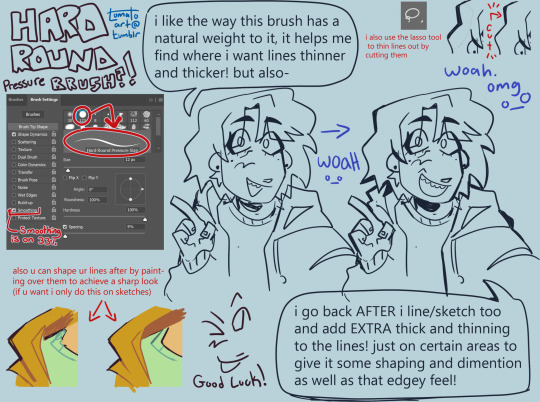
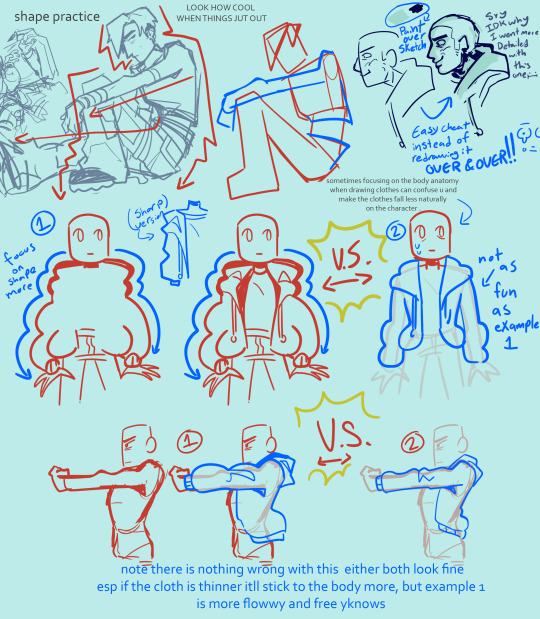
but if ur desired style is thin lineart that is cool too! tbh it was just harder for me as a beginner
sometimes artists think they need to do full lineart for everything and then hate how it looks compared to the sketch, do not fear i will introduce u to my bff: painting over a sketch, extractinging the lines, then calling it line art. i only do this sometimes but its a fun exercise-ish thing to do in a pinch. example:
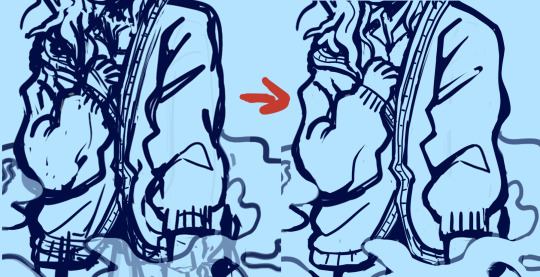
finding what shading fits ur art. sometimes ill see ppl starting out who have a style thats very simple, but they use a very detailed rendering process on it. this is not something id ever police of course, art is each persons own choice! And it CAN work. It can be so cute! but sometimes mixing two very contrasting mediums of art can throw off the “put together” look of it. i use to abuse the airbrush tool thinking it made my simple style look super cool and detailed, but looking back on it now those pieces looked a little off, having such a simple style have somewhat more realistic shading. dont get me wrong the ability i see ppl use rendering like that is so insanely talented! but i found cellshading to be a good match for cartoony art like my own. a tip i learned way too late abt that is rather than shading each layer by color picking a darker color, instead use a clipping mask over the entire art (above line art too as I color my lineart) and lasso tool the areas u want shaded + fill it w a saturated purple then set to multiply + lower opacity. also, sometimes coloring can come out chalky looking when u meant for it to be smooth and transitional, i think this comes from overshading and overlighting pieces without reason. pay attention to where the light source is, and focus on making the shaded and lighter areas nice shapes that cover the necessary areas, then u can add additional shading to the smaller details of what should have a casted shadow/light
its good to spice up ur art now rather than later, focusing making ur art pop more w backgrounds will help ur coloring skills look better too! i dont mean detailed huge backgrounds, a small lil color pallet and design rather than a blank white bg. like this will make u feel better abt it or at least it helped me *sweats* yeah:

beginners tend to draw blank faces like “:)” but I think a good thing to do is try and get silly with expressions early on. It’s okay if the mouth hangs off the face cartoonishly with joy or shock, it’s ok if the eyebrows are super high in surprise.
tracing and pasting it as is (already said this but I’ve seen ppl do it a lot with hair styles and it makes it look alienated from the rest of the style) (final fantasy fans found critically injured) n if need a ref for a pose, using a real humans anatomy as-is doesn’t look quite right on a cartoonyish drawing. Shortening torso and legs usually comes out of this for me!
flip ur canvas i promise u it’ll be less embarrassing over time!
using guidelines for perspective and foreshortening is GREAT. Do it stylistically rather than realistically to add some groove to it...yay. Having silly perspective in art can make it look like a 10 so easily opposed to a normal front facing sketch. Look at cool poses from fashion magazines! Don’t be scared to draw something you don’t feel confident in conveying perfectly, this is why progress redraws exist :)
Drawing the hairline b4 u draw the hair is great, it helps u understand where their hair flows from, where it starts and stops, AND prepares u for drawing bald ppl. Also don’t make the head too big, the skull IS bigger up top, but sometimes I see an alien head affect.
Anatomy is an interesting mistake that beginners make a lot, but it’s one they find harder to notice! When I started out, all my art would be SO wonky, but I didn’t even realize it! It still happens today too! specifically though I see beginners struggle with the arms in this department. My advice is to try and measure them out and make sure they don’t go past the knees, and are the same length as each other when Unfolded. asking for criticism is hard but it helped me realize when i would make something bigger/longer than it should have been in my art, and stuck with me being able to go “oh... i see it LOL”
clothing wrinkles- do not over do it! Too many wrinkles and shading can look unpleasant and wirey- like a plastic table cloth all bunched up which isn’t exactly what ppl wear. pay attention to gravity too
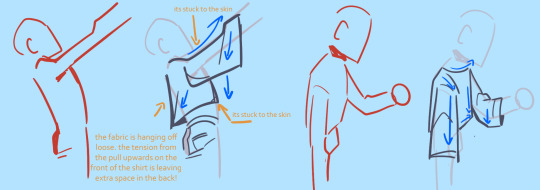
I hope this helped even a lil im sorry tht I’m not very good at explaining or didn’t have much to sayyy! If u have any troubles no guarantee I’ll have the answer, but ur always free to ask!
114 notes
·
View notes
Note
min WHEN I CATCH YOU MIN‼️ MIN WHEN I CATCH U.gun pointed in your head until I see how u draw anatomy and how u color
Your lovely jia lover 😉
HI I hope ur the anon that asked it earlier cause I was dumb and deleted it by accident 😞 I literally had the whole thing written out to
But anyways
Disclaimer this isn't rlly a tutorial cause half the time idk what I'm actually doing so this is more what my art process is
1. Basic shapes (❓)
I legit dunno how to put it into words so have a visual interpretation
So like most of the body is broken down into shapes especially for the torso
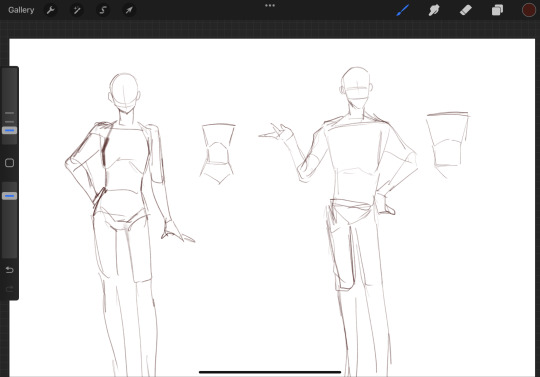
Because I have crippling anime style syndrome the leg proportion are often longer than the torso
Also for the torsos, when I draw more feminine bodies the hips are usually as wide as the shoulders and for masculine torso the shoulders are wider that the hips
But in the end it really depends on the art style and the body type cause like I said I have anime style syndrome so I don't include variations in my art alot (even though I rlly should)
2. Poses n stuff
For poses I usually start with lines that vaguely look like the pose I want like it literally looks like this
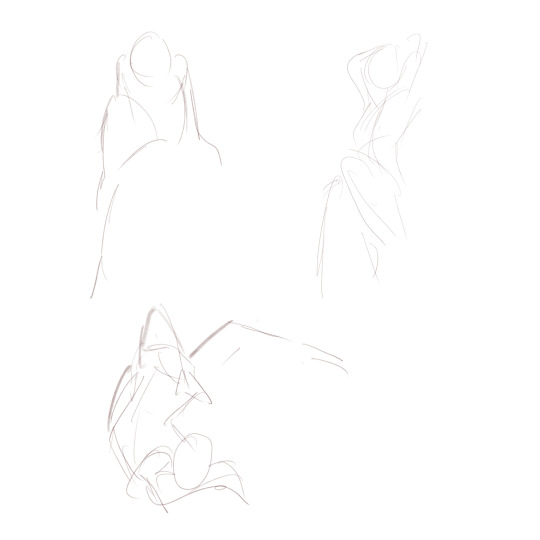
I don't put a lot of thought into the anatomy at this stage because if I worry too much about the anatomy here, I end up spending too much time trying to fix it and never actually getting the pose out of my mind
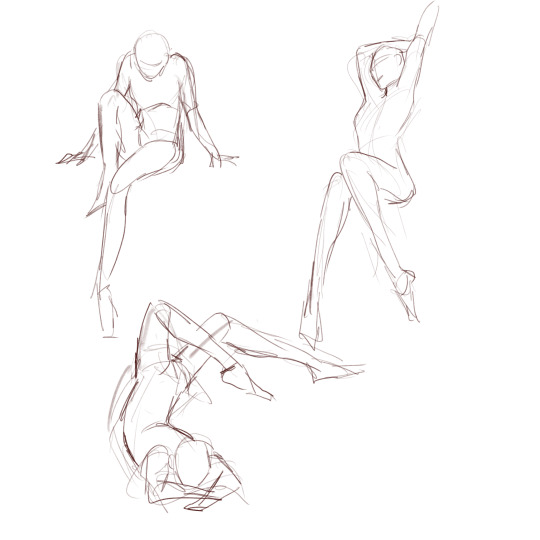
The examples here are rlly shiet cause I literally sketched it under a minute but I then try the properly solidfy the shapes and only after that I start agonizing over the anatomy and correcting it
But I won't show it here for the sake of my sanity and hand
3. Refs + practice
I feel like a hypocrite saying this bc I don't use alot of refs but refs are rlly helpful
Like seriously
The only reason I don't use refs that much is cause half the time I can't find the one I want but when I do photo studies vs pieces that I don't use refs in, the art that uses refs definitely look more natural
And ik literally every artist says this but practice is such a big part like I literally drew everyday for 3 months after watching atsv and my anatomy was just so much better
Bc I drew so much
But yea idk if this is actually helpful cause I'm so sheit at explaining cause even now I still don't know wtf I'm doing so I just wing it and pretend the art looks good (ie. delusion)
I might make a separate post for colouring but idk how that will go cause once again, idk what I'm doing hehhehwhhahah 🤡🔨
13 notes
·
View notes
Note
Hello,
Your art is absolutely amazing, and your nsfw…🥵🔥. I’m curious, do you use references for the lewd poses (mainly asking about your most-recent post), or are you just that well practiced? Love your art either way. Thanks for continuing to bless the KouAo nation 🙏
thank you so muuch 💕😳
mostly i don't use reference, altho i do save stuff
i just always forget to go and check it 😭
But the reference I keep are usually general anatomy stuff, and when they are poses, it's sfw cuz it's not my fav thing to go through random people's nudes and videos, and most of the time they are either not the type of perspective i'm looking for or they're usually repetitive and stuff that I already can draw 😭
sometimes i use ref pics of myself, but usually they're small parts, i haven't tried doing a full body pose yet
5 notes
·
View notes
Text

Drew my fiance's fursona for fun and anatomy practice!! I referenced this pose from some Stardew Valley fanart by fattlestacks on Twitter. Not traced, just referenced, but I wanted to credit them just to be sure. This pic isn't fat fetish art, though, I swear. xD I just googled "chubby man" or something like that for a pic to reference and that popped up lol!! This racoon is a thicc boy.
Also his top is supposed to be a binder but I don't really know how a binder wrinkles whenever worn by a guy this chubby so it just looks like he's wearing a very ill-fitting tank top xD Clothing continues to be a struggle for me.
Overall I'm pretty happy with how this turned out, since the anatomy is a lot better than stuff I've drawn previously. I took some advice from my boyfriend about anatomy. If you have a reference picture you're using and you're using a digital tablet, you can trace the ref three times to get a feel for it, then reference it three times to make sure you have it down, and that third referenced sketch is what you use. It helped a LOT! Tracing is usually one of those OMG NEVER DO THIS type of things in art, but it can be a great way to learn, so long as you're not using the trace as your final piece!!
Final parting thoughts: A fun fact about this fursona is that, to my knowledge, he doesn't have a name yet. I affectionately call him Nipples because the initial drawing I got of him reminds me of Knuckles from Sonic, and therefore the "Nipples the Enchilada" meme xD

This is what I had to work with xD I changed the "fuk popo" to "ACAB" in previous drawings, but I got lazy and didn't add it this time.
3 notes
·
View notes
Photo
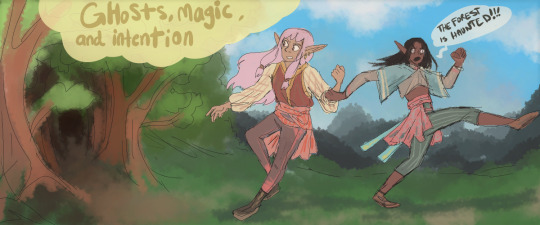
Just a short info post on the topic of people accidentally haunting themselves through use of magic, and what is usually done when people believe they’re being haunted. Completely random topic in the middle of things I’d rather be focusing on (the avirre’thel, elven history, etc.), but... apparently my brain was thinking about this so I had to write some about it lol
(actual info under read more, as usual..)
---------
[[ ALSO: there’s still a glitch where when viewing blogs on the side on tumblr, read more’s don’t work and it shows the full text, so I’m sorry if this appears full length. If this happens just view my blog in a new tab or something instead so there’s not long strings of text... lov tumblr being a very functional website..]]
Technically, there's no such thing as ‘spirits’ in Nanyevimi (at least not in the way we usually think of them). There are a few things that may mimic the presentation of something like a haunting, a spirit sighting, etc., (which I’m about to explain), but these are magical in nature, rather than just an actual function of the world.
The most common phenomena that can mimic the presence of some sort of ghosts, is... essentially, people haunting themselves??? As in any world, people in Nanyevimi are still capable of convincing themselves something is true through confirmation bias based on their preexisting beliefs. Which, when much of the population consists of magic users.. can become a bit more complicated, as they do actually have the potential to unknowingly effect their surroundings.
Essentially, anyone who's capable of using magic, even if they don't have very strong abilities (actually, especially if they don’t/are relatively untrained), can end up performing small feats of magic accidentally. This is why latent magic can be so dangerous (as explained in this post on latent/undiscovered magical abilities HERE (link)), and why especially the more powerful you are, the more significant it is to be exceptionally well controlled, lest you accidentally blow up your house or kill someone lol..
So, if it's something believed by a large group of people, all of whom can use magic (such as a small rural town of elves), it can almost end up becoming a self-fulfilling prophecy.. A myth starts, then people begin to fulfill the myth (unknowingly) through VERY small energy barely noticeable accidental acts of magic. For example, a mysterious breeze coursing through the forest on a day where it otherwise wasn't windy, and people are like “AAAa! See! The forest is haunted!!”, when really it was one of them which caused the breeze to happen in the first place lol. Which only makes more people believe and do the same thing.
Collective energy output like this can sometimes end up functioning similarly to an enchantment, without an actual enchantment having been placed by anyone, where the more collective belief and accidental magic bestowed into something, the more that that thing actually follows through, in a series of tiny acts over time that just gets worse the more that people buy into it*(1).
So for example, there may be woods that are thought to be 'cursed', where bad things always happen to the people who travel through there, but rather than it being the doing of some evil ancient monster (like the locals believe), it's actually just.. literally the people who live near the forest themselves. The small bits of accidental magic seeping from them act to confirm their intentions, and cause little accidents like a branch falling on someone, someone's hat blowing off, a pothole in the road that knocks someone's wheel off their cart, etc. While it wouldn't really be anything extreme*(2) (crafting actual apparitions, monsters, natural disasters or etc. would take far more advanced magic than what could just happen without the person knowing they’re doing it), these small things would still be enough to reconfirm the myth over time.
(for more info on how magic, enchantments, etc. works, you can read the large masterpost sort of thing about it HERE (link))
Interestingly, you rarely if ever see this effect of “self-haunting” occur in mostly Jhevona populated areas. This is thought to be because of their cultural focus on extreme self-control and awareness of their magic, thus making it much less likely for them to unintentionally use magic. For someone so deeply in tune with their internal intentions and awareness of their magic, accidentally using magic without knowing it would be exceedingly rare. (Though in cases where this has happened, the effect is usually much more extreme, since they're capable of far more advanced magics... which is part of why they prevent this stuff from occurring in the first place. ).
These self-hauntings also never occur in non-magical societies, and you actually rarely have stories about “ghosts” or curses or etc. in their cultures. Human (and other non-magic) cultures in the realm certainly can also fall prey to psyching themselves into things and etc., so it's not like because they can't do magic they're suddenly immune to superstition, they have plenty of similar-ish beliefs, but it's just much less prevalent for it to be genuinely reinforced in their cultures, since they usually can't find much tangible evidence. Like, if they believe something like a curse, it's usually just based on "a feeling" they get, or based in it just being a tradition that is passed down. They culturally would describe it more as a sort of ‘energy’ instead.
So, humans/non-magical people in the realm may have beliefs more like “Stay away from the woods because they have a repellent force, and they don’t want us near them/the gods don’t intend for us to go into them/we’ve hurt the forest’s feelings and are not allowed there now”, and would also not have much evidence for this aside from maybe a few personal stories or “gut feelings”. While among magical groups, it may be described more as “There is an evil ghost haunting these woods!/Someone has cursed these woods!”, and they MAY actually have have physical evidence of it existing/something that seems like tangible proof rather than just suspicion (despite it still usually just being an accidental magic placebo). Beliefs like this can stick around in certain magical cultures more prominently , because they're not as easy to discount or disprove if locals have apparently witnessed actual physical evidence of it, etc. Because it feels stronger and more personal to them, they also usually attribute it to ghosts/spirits (sometimes of ancestors), or more active/deliberate and personified parties, rather than just obscure feelings or the vague workings of gods.
There's no real solution to people haunting themselves, other than for the group to learn what's going on and ALSO learn better magical control and discipline so it's less likely for them to cast accidental spells. If they ONLY learn what could be going on, but don't train their magic, they'll just end up repeating the same thing later, falling back into haunting themselves, since they still have underlying issues with accidental spells.
Due to their generally higher mastery of magic, sometimes Jhevona (if there are any groups of them in the local area) will be called to help with stuff like this. Kind of like teams of paranormal investigators, except they're just magic specialists who may come in and help test for traces of magic in an area (to see if people are casting spells accidentally or not), better train the people in the area in their magical control, etc. If the Jhevona is powerful enough in enchantment magics, sometimes they can even kind of just slap a band-aid on the issue by simply overriding whatever magic is being done with a larger enchantment which then blocks the accidental magic from coming through, effectively ending the self inflicted "curse" in the area, though it’s not a very long term solution, and people may end up haunting themselves again in other ways.
(Though sometimes an over-riding sort of enchantment can be done to help diagnose the issue, like if they do this and the “haunting” DOESN'T go away then.. you may have some more serious problem on your hands, like a mage causing trouble intentionally, or etc.)
There are a few other things which can, on the surface, resemble a form of ‘haunting’.. Mostly just, enchantments done by malicious parties (actual people though, not ghosts.. just like.. random mages who want to trick people in a small town out of their money or something), and also occasionally forms of soul magic gone wrong can trap someone’s soul in an object or place in an unnatural way, and this can mimic the existence of ‘’spirits’’ or etc., though this one is very rare, since soul magic in general is pretty rare. I may elaborate more on those two options later, but this post was mostly about self inflicted “haunting” through accidental magic lol.
[ *(1) note: Magic scholars disagree on whether enough collective belief in something can ACTUALLY create an enchantment without an enchantment being set. All magic seems to based on intention, but especially enchantments are extremely literal in that sense, so it could follow that if enough people intend something, and enough people are accidentally seeping magic into that intention and giving it an actual energy behind it, it may genuinely become it’s own ‘independent magical function’ (what enchantments basically are), “feeding” itself (as all enchantments must be recharged over time) on the magical energy output of the collective group.
But, it’s commonly thought (and observed) that enchantments must be specifically set by one individual (though that individual can draw energy from others as part of it), and that they also take a great deal of magical energy to set up (which is why it’s mostly Jhevona and other higher-energy magical species who do them, rather than lower energy beings like elves). Whether a collective group of people could create a genuine enchantment function just by casting enough intention and fueling it with accidental magical leaks is still uncertain, but would definitely be interesting from a magical study point (and would confirm some less common beliefs that magic to a degree operates on it’s own.. since this would effectively be like.. an enchantment casting itself just because there was enough intention and energy going around. But, that’s a debate for the magic scholars (who already spend most of their time arguing about this stuff anyway lol).]
[ *(2) note: It should be noted that this ‘unintentional magic’ really only manifests through minor physical alterations of the environment, or other very small simple spells. Things like Illusion magics and etc. are so powerful and inaccessible that it's not like someone could just 'accidentally' do them, even if casting illusions or hearing voices would go along with the idea of placebo hauntings. Though in some ways magic can seem like it has a mind of it’s own and is never fully controllable, there are still plenty of user based limitations.
Much of magic is intention based, meaning it is affected by your mental state. If you try to cast a spell to burn your house down, but you don’t really actually want to burn your house down, you will have mental resistance (unless you’re immaculately well trained) and the spell will probably not actually work. You'd end up casting the fire somewhere else and burning a random stranger to death or just shooting water at your house or something instead, etc.
Which of course, this means that SOME things can be done on intention alone.. but these primarily involve pure energy magic, or simplistic elemental magic. Some basic magics like these can be utilized (to a primitive degree) without training or much knowledge, since they mostly consist of pure bursts of unaltered energy, rather than a careful manipulation of energy or matter. Most higher level magics are too complex and require a lot of very intentional manipulation based on former knowledge, so it'd be nearly impossible for someone to do them just 'accidentally' .
Unintentional magic usually exists solely in the form of like, accidentally creating a breeze, or moving an object, shooting out a burst of energy at someone who has attacked you even if you didn't MEAN to hurt them and it was just an accidental self defense out of your body being surprised (also why they say to never sneak up on mages lol), accidentally setting a fire, etc.
Anyway, I just wanted to clarify that it'd be impossible for someone to 'accidentally' perform some feat of magic that they're not trained for/otherwise incapable of.
If you're ALREADY an illusion magics user, you could accidentally use illusion magics perhaps under certain specific conditions, but if you're just some random elf with very little magical training who's convincing themselves of a placebo haunting, you're not going to be able to break out some master level illusions spell if you can't already do that normally, etc. “Weak” accidental magic can still cause massive damage, kill yourself and people around you, destroy your environment, etc. even with just simple pure energy magics, so like.. it’s still Dangerous, and unintentional magic can operate in pretty hazardous ways, but , you’re also just not going to be able to accidentally do stuff that’s WAY beyond your scope to already reasonably be able to do. ]]
#worldbuilding#also I mean I guess is an important thing to establish about the world#though I think.. I may have mentioned spirits or something in the world before.. as usual.. I have a lot of information I'm working#out so a general rule is whatever is the MOSt recent is also the most accurate.. maybe 4 years ago I had some ghost OC or something#but this is the official consensus now lol#ghgh also I love all the sketchy super quick art that I do.. not like from an This Is Good perspective but in the sense that they're all#humorous to me like.. I truly just sat down at the computer with 0 knowledge of anatomy completely freestyling what a leg looks like#and it shows hghgjh#which is completely my fault because I do not use references.. like it was actually bizzare to me to discover that most artists in practice#will like look up references before drawing and have anatomy ref or something in another tab which they reference as they draws#or etc. like HHgh... I just plop out whatever bizzare anatomical concepts exist in my head until it seems 'good enough' and leave it at that#everything I have ever drawn I have never used a reference for.. which is why.... I am Not Great at certain things#but I still always forget it's like one of those things where I always thing 'huh! if I actually want to get better at anatomy#I should start using references when I draw!!!' *completely just does not use references the next time I sit down to draw*#*looks at art ad wonders why I'm not satisfied with it* 'hmm I should start using references!!' *completely forgets ..#my brain is just like 'hmm I think i will cause problems for myself on purpose'#i have no place to complain since I do it to myself by not practicing with references.. but alas
10 notes
·
View notes
Note
Hey there! Do you perhaps have any websites/refrences/ect for light sources? I've always struggled with shading and Im pretty sure other artists could benefit from some light source things too!
book rec / expert info lol
for a really bomb book about light sources I have read & is regularly recommended by pro artists in the industry, check out Color and Light by James Gurney (disclaimer, this is an affiliate link to Ebay lil indie book seller, not amazon for ethical reasons lol)
Here’s a few random notes on general light sources before we hit my over kill method to practicing lighting.
Sun: strong, strong light source that is usually up high.
When it’s sunset/rise, it’s even warmer. creates strong highlights, depending on the surface / material and also is responsible for sub-scattering effect. The link is to resources on that subject.
Also generally the source of bounce light, which is not that bright, but when you remember it, helps the subject look way more realistic. Check out this demo on Proko https://www.proko.com/shading-light-and-form-basics/ (bc I don’t want to directly embed the image from another artist. Want all the traffic to go to him!)
Other points of light like candles, lamps, etc can be strong or weak, but the fall off is usually pretty great compared to the mega watt sun. Light fall off is pretty rapid, actually! I’d check out some ref photos or really look around.
A guide to experimenting with lighting set ups
For experimenting with light set ups, I recommend practicing with 3D lights so you can see how light sources works when you move it around objects. This way you can do a lot of practice and you won’t have to find a new ref all the time. Though I definitely hop on Unsplash.com a lot and doing lighting studies there as well.
This answer is kinda overkill in terms of complexity, but once you get it set up, it’s freaking litttyyy and easy to use!!
I suggest finding some free (or paid!) 3D models on https://sketchfab.com/feed or https://www.cgtrader.com or any other site with 3dmodels.
Then grab yourself a copy of blender, the wonderful open source project https://www.blender.org and import your file. I had to import obj to get this free doggo to show up.
Add in some lights, I used tried light add-on that is easy to turn on the settings, you don’t have to download anything.
https://docs.blender.org/manual/en/latest/addons/lighting/trilighting.html
Recommend this tri-lighting set up bc it’s flattering but still ultra customizable.
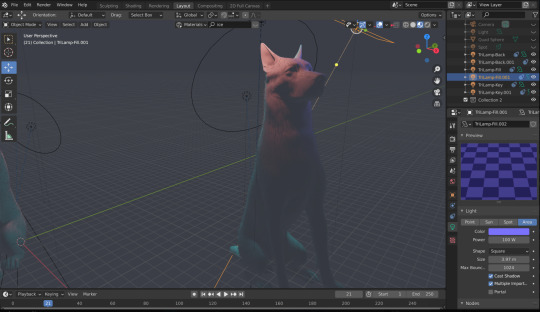
For the rendering preview to come on, make sure you have the button selected how I have it here:

Then go wild and change all kinds of color and position settings and try out new lighting schemes!
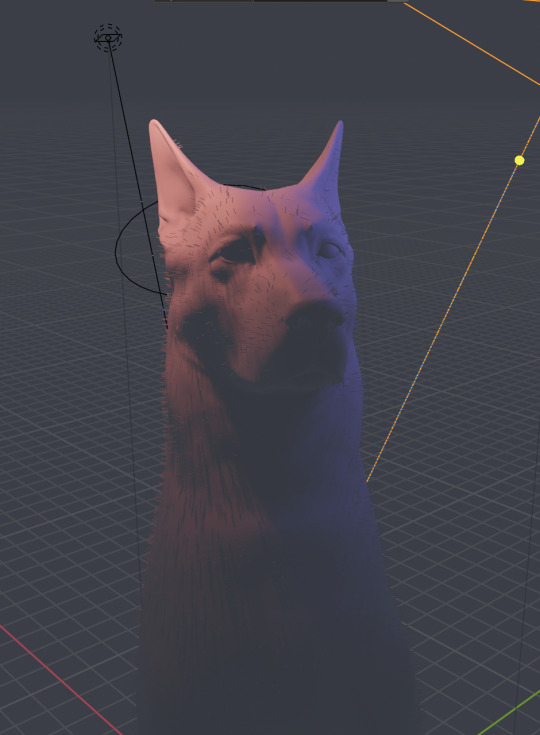
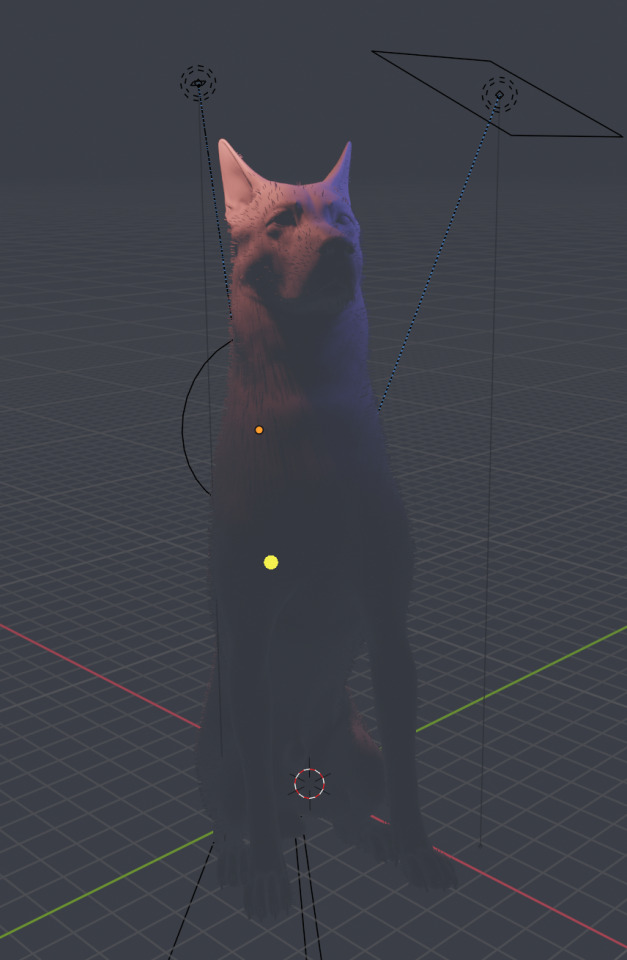
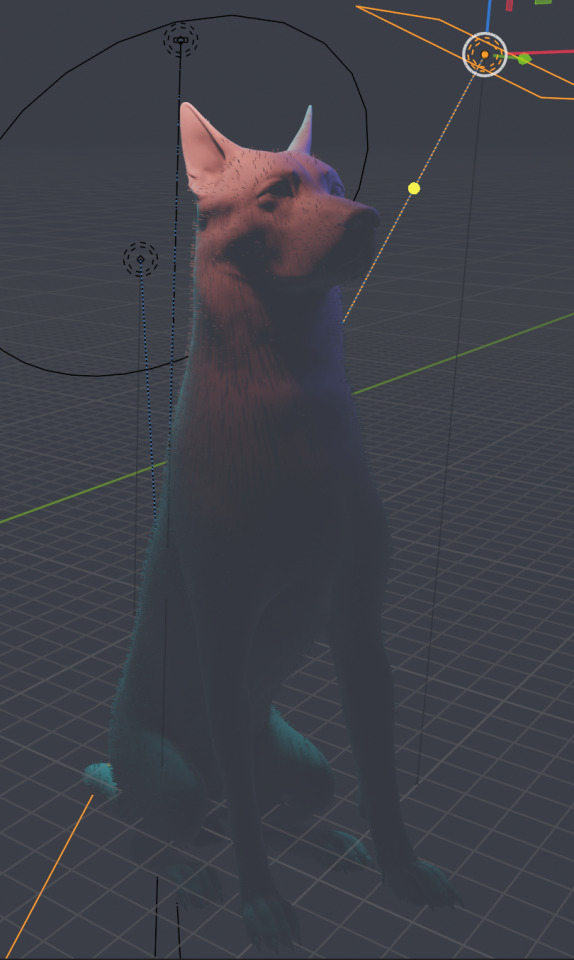

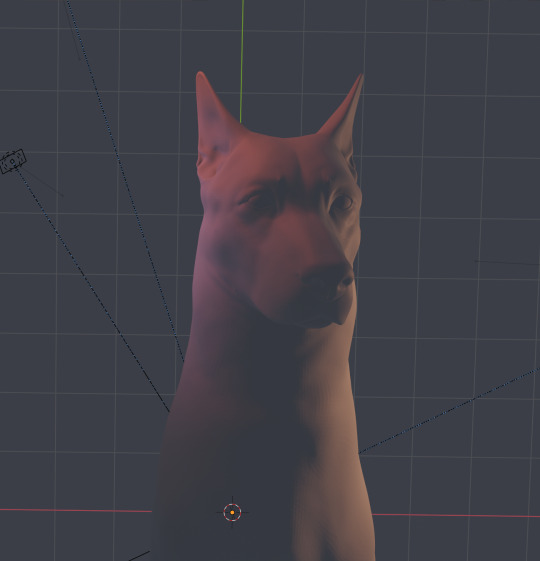
For faces, this is a great tool and is much quicker to set up.
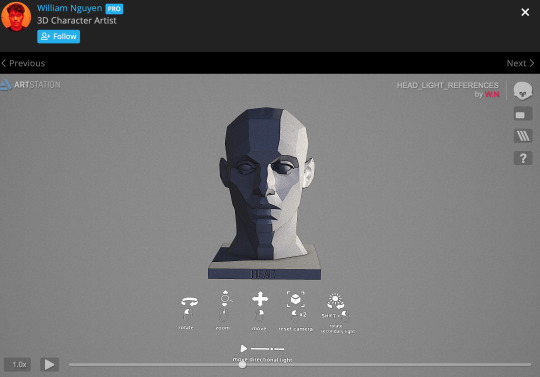
https://www.artstation.com/artwork/GX3Ax1
Thanks for reading! If this post helped, please consider reblogging it or sharing it with your friends! ❤️
More useful articles and resources / support Art-Res | my art tumblr | Idea Generator | Check out the Art-Res Anatomy Ebook!
#lighting#color#artists on tumblr#art help#art tutorial#digital art#answer#asking for a friend#art-res
3K notes
·
View notes
Note
hey can i ask for a tutorial or guide on how to draw a cat body? i've been struggling for days
just to get it out of the way since anyone you ask is going to say this, references are your best friend and will make this a lot easier
a friend of mine shared this site which has lots of good references, not just for cats but lots of things. if im looking for something specific, i usually google something like "cat curled up" and just scroll for a while or use multiple references to get what i want.
but as for how I draw a cat body, i use references but honestly a lot of what i do is a result of just having spent so long studying references (and how other artists drew them! sometimes studying what artists are doing can help you translate realism into whatever style you're going for) that i kind of just know where certain bones go/how the muscles would stretch or contract
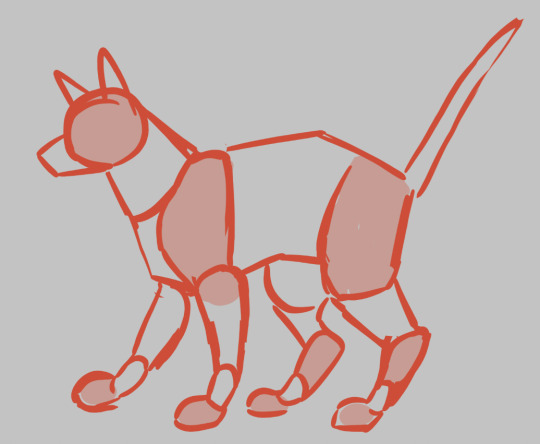
this is how i tend to visualize the body at its most basic. the parts i highlighted are the pieces i use to ground the anatomy: the shoulder, the haunch, the elbow, the ankle, the paws, and the skull. their shape tends to change very little from pose to pose, which is why i exaggerate/define them so strongly. they're usually what i sketch first and use to get the pose the way i want it. everything else is stretchy and fluid to "connect" these pieces of the body.
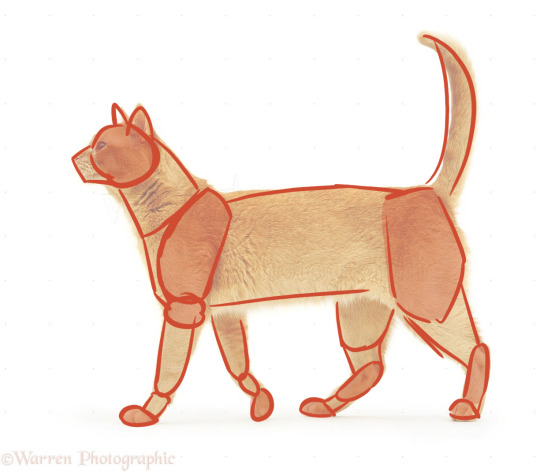
here's an example of the parts using a photo from that site i linked
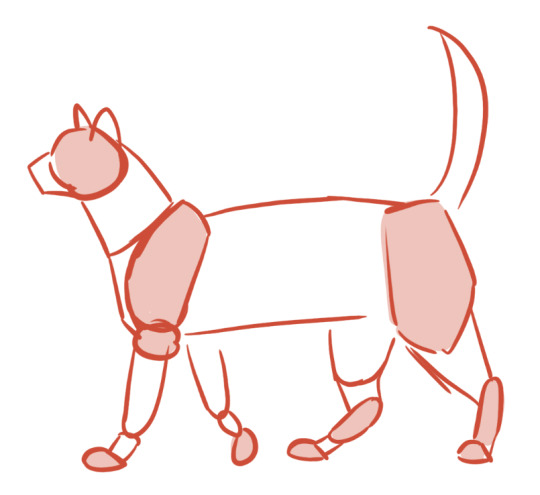
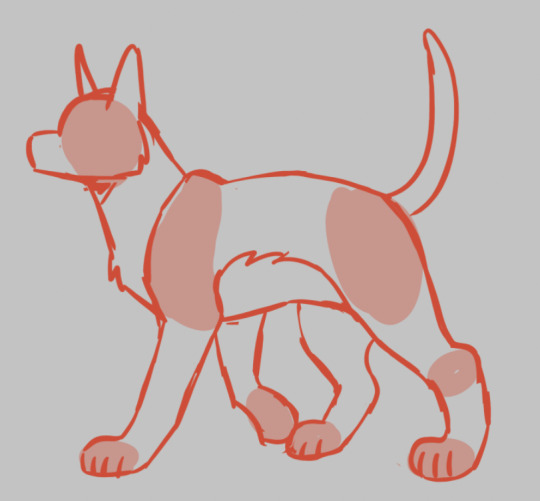
and the way it looks without the ref, vers what i drew by looking at the ref!
these are pretty standard walking/standing poses, but the idea works for more complex poses.
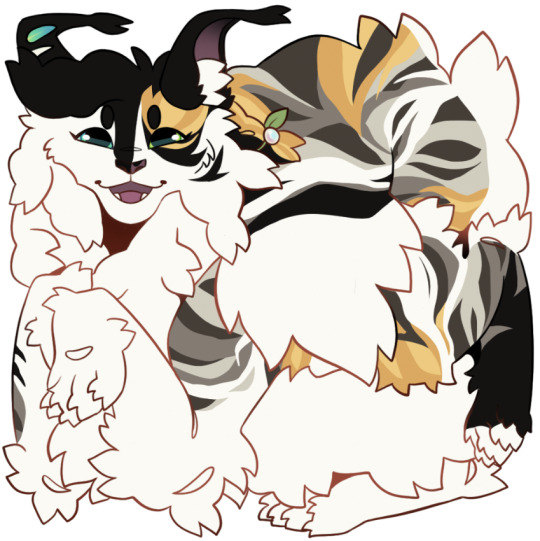
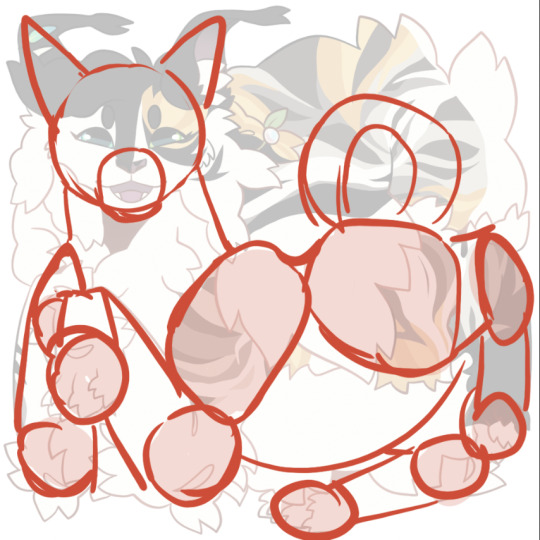
i havent really said much about it, because most of what i draw are refs, and they dont really have dramatic poses or difficult perspective, but its up to you to decide how much anatomy you're willing to sacrifice to get a more fluid motion, or a dramatic shot. i think this is where those guiding "pieces" of the body is helpful for me, because i can lay down those pieces and then do what i need to to connect them, so i may lose a little bit of exaggeration but the body doesn't look broken.
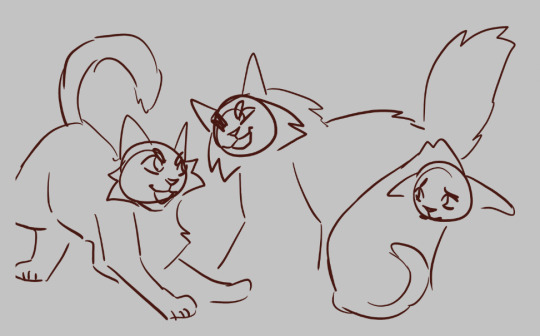

you can see that in action here, with this anniversary piece i did. my first sketch was only meant to get down expression, pose, and movement (i changed raven's completely, lmfao) and unfortunately i dont have anything for the steps inbetween because i think i refined on one layer. but i kept the vibe the same even after cleaning up the sketch and fixing the anatomy issues.
fur is one of the last things i draw when i draw cats. i like to get the body shape and movement down first, and then cover it with fur if i have to. i think this ref is a pretty good example of that
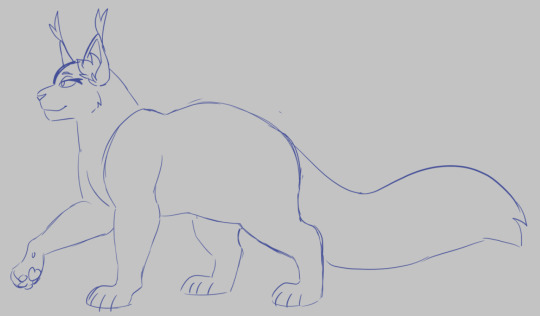
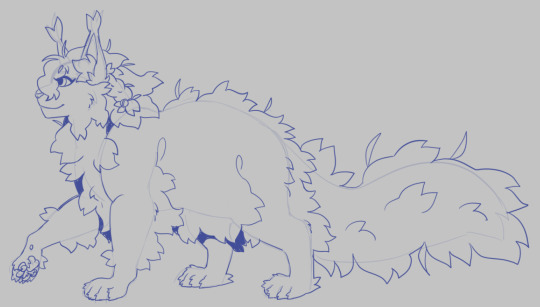
on the left is how i start most of my drawings, getting the pose down and everything where i want it. i make edits to this until i like the body shape (notice how the belly is much larger, and all of the limbs are thicker + the paws are big) then i use that sketch as guiding lines for all of the fur placement. the fur here ends up covering nearly all of the body, but it still looks fine because the anatomy was there to start with
i hope this helps anon skjfdhfkgjh ive never made a tutorial like this before. there's definitely better ones out there by other wc artists, but i dont have links to those posts on hand, maybe some of my followers can link them? good luck to you!! ill leave you with one last piece of advice you'll also hear a lot: just keep drawing! we all improve with time and practice, and are always learning and trying new things.
#and that post isnt including all of the art i did before i had the ability to make digital art#ive got some oooold paper drawings
12 notes
·
View notes
Note
(I am so sorry for the essay I got carried away) Okay, so whenever I find a fanartist I enjoy I have a habit of consciously or unconsciously analyzing what aspects of their work I enjoy and certain skills that stick out to me. That way I can see what I can apply to my own work and see what I want to improve in. I've always been passionate about storytelling and character expressions. What really floors me about your art is how expressive your body language is and *especially* how NATURAL-1/3

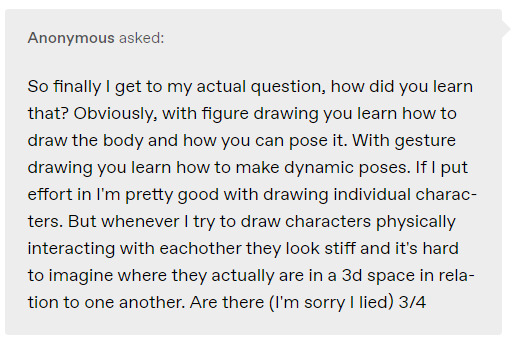

HELLO, fellow artist! I appreciate your comments, means a ton! I don't think you were being abrasive at all lol I personally think I'm still leagues away from where I want my art to be, as is the artist's plight i guess. But I have been drawing for a long time, so I feel comfortable with sharing some tips. I just hope it helps! ^^; I will attempt to answer your question below the cut:
SO... -sits-
I get it. I know the desperate feeling of wanting to become better but not knowing where to start. I feel like artists are always playing catch-up with their own skillset, because sometimes we understand something better than our hands can create and that can be very frustrating.
For starters, the best piece of advice I can give is to use references. I know that's like basic 101, but I grew up in early dA days where using ref was seen as "cheating" so I always stress its importance. If you get good enough at anatomy and figure drawing that you can potentially draw poses from memory or make them up, that's all well and good. But there's a difficulty spike when it involves multiple characters. I would never successfully draw characters dancing (for example) without a reference. In the industry, references are as much of a tool as your pencil/pen.
In terms of my own references, I don't have any particular ones. I usually search google for specifics, or ask Cheri to pose for me lol. BUT, in the absence of good refs, I do have handy 3D models. On the iPad (i think it works on the phone as well) there's ArtPose and PoseMaker. I know there's a free web poser called JustSketchMe (never used it, but seems to be similar in nature.) ClipStudio, if you have it, has their own 3d models as well, and its by far one of my favorite tools. I think a program like that would certainly help envision how characters are placed in a 3D space. These things are hard to visualize in a 2D medium without a fuck ton of practice.

I would also suggest starting out simple. I feel like a lot of us from the get-go wanna go right in to throwing characters at each other hugging or kissing, etc etc.
Try showing characters in conversation, or giving each other meaningful looks -- simple can be effective. Also, try starting out small with thumbnails or margin doodles. I swear I only got better at drawings because I spent 50% of my school time doodling ideas on my notebooks haha
have some old work as examples:


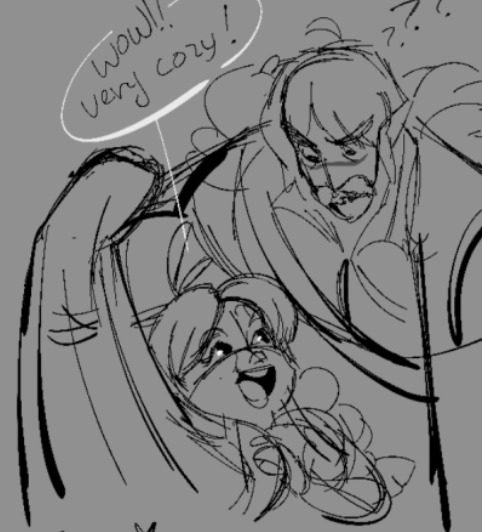

In conclusion, I can't feasibly come up with any super insightful or magical words of wisdom that can give you the exact answer. With art and improvement, it usually always comes back to "practice and use reference." ^^
I wish you a lot of luck on your art journey, anon!
#pig talks#ask the pig#anon#art advice#i guess??? lol mostly me rambling aaa#haha these drawings have never seen the light of daaaay
77 notes
·
View notes